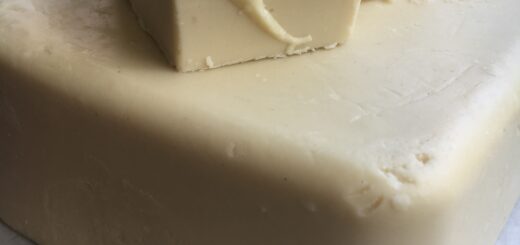Essential Oils
How much oil to use depends on several factors including who you are using it on, how you are using it, how much carrier oil/solids you are diluting it with, what essential oils you are using and personal preference.
Essential oils have recommended safe maximum dilutions. These are based on just one essential oil being used. If you are blending several essential oils, you need to divide the dilution percentage by the number of essential oils being used. For example, if you are using 4 essential oils in a facial balm, the total percentage of all the oils combined should be no more than 1%, the maximum recommended dilution for use on the face.
Guide dilution ratio:
1% dilution: For use on face or by those with sensitive skin
Up to 30 drops per 100g
1.5-3% dilution: Daily use, creams, massage oils, baths etc
Up to 45-90 drops per 100g
4-10% dilution: Short term targeted use
Up to 120-300 drops per 100g
10% dilution: Short term targeted use for pain and wounds
Up to 300 drops per 100g
30 drops of essential oil are equal to approximately 1g.
We only use a 1% dilution in our skincare products, however the wound balm recipe, which is for short term targeted use, has a 10% dilution ratio.
We have included some useful information on the benefits and things to be aware of for the essential oils that we use within the class and also on some of our favourites. The essential oils are marked as Calming, Restoring, Uplifting and/or Revitalising as a guideline to help you create your own blends.
As well as having a multitude of therapeutic properties when applied to the skin, essential oils also smell wonderful and their inhalation is considered highly beneficial, after all, their use is called ‘aroma’ therapy.
There are of course hundreds of essential oils available for you to explore and enjoy. Remember to check safety recommendations before using any new oil.
While the majority of essential oils should only be used once diluted, those with sensitive skin or who are prone to allergies should consider performing a skin patch test before using any new oil or oil blend. To do this dab one drop of the oil behind your ear. If irritation occurs within the following 24 hours wash the area thoroughly and discontinue use of the essential oil.
In the event that irritation occurs an oatmeal paste can be quickly made by placing a cup of oats in a muslin or cotton cloth, soaking with warm water and massaging until a lather forms. Gently apply to the affected area and leave for 10-15 minutes.
Medical advice should be sought for any adverse reaction.
The Sun and Essential Oils
Some essential oils are phototoxic which means they react to sunlight and can cause a bad reaction on the skin. Users should sufficiently dilute or avoid direct sunlight for 24 hours after use of angelica, bergamot, grapefruit, lemon, lime, ginger and tangerine.
Pregnancy, Children, Medication and Essential Oils
The list of essential oils to avoid while pregnant or nursing and that are not safe for use on children is extensive.
Further advice should be sought from a qualified professional before using any essential oil or product containing essential oils if you are on any medication, pregnant, nursing or are using them on children.
Medical advice should also be sought from a qualified professional before taking any essential oil internally.
This information is provided for recreational use only and is not intended to provide diagnosis, treatment or medical advice



